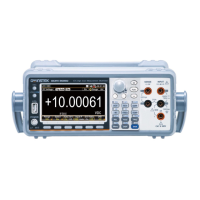DUAL MEASUREMENT
75
The error influence on Dual Measurement (V & I)
While dual measurement of voltage and current is being
executed, the route from DMM internal circuit to the
LO terminal circuit for measuring voltage is totally
identical with that for measuring current, and thus the
resistor within the route is commonly shared by the two
measuring circuits. While measuring current, the resistor
within the circuit will generate a voltage drop. When the
internal resistor of LO terminal is added to the external
load resistor within the circuit, the accuracy of voltage
reading will be influenced.
Fuse
Rshunt
Rline
3A
Rline
HI
LO
DMM INPUT
Vs = Voltage source
RLoad = Load under test
Rint = Current terminal total impedance containing
Rshunt + Fuse + Rline
When different current range for measurement is
selected, Rshunt will vary accordingly.
For example,
Vs = 10V, Rload = 10 Ω, Vs = 10V, Rload = 10 Ω
If the total impedance passing through current
terminal is Rint = 0.5Ω, the ideal measured voltage will
be 10V regardless of impact on load from voltmeter
input impedance. The calculation for actual measured
value is 10V * = 9.52381V.
Error (%) = * 100, this error is
applicable to not only DC but AC measurement as
well. The influence will be probably more serious
depending on varied actual conditions.
w ww. . com
information@itm.com1.800.561.8187

